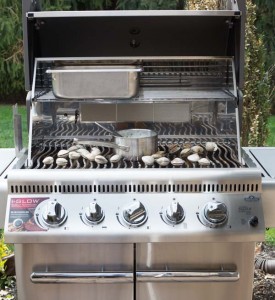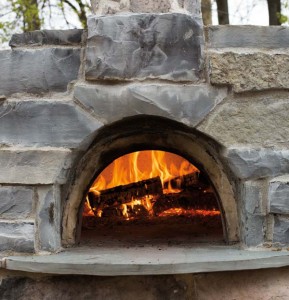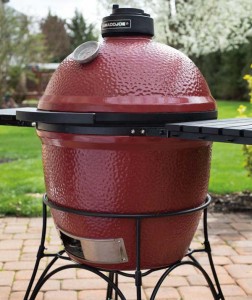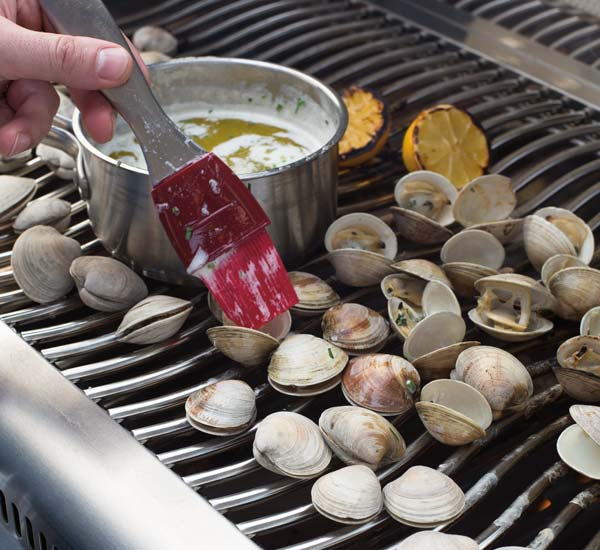The grilling season is in full swing. Perhaps you’re in the market for a new grill – the perfect Father’s Day gift – or have your eye on one of the outdoor-cooking options that have become extremely popular over the past decade. Whether it’s a shiny new gas grill; a pellet-fed, set-it and forget-it smoker; a ceramic-lined Kamado cooker; or even a wood-fired oven, the choice is yours.
Gas Grill
 The Pros: The beauty of a gas grill is that you can simply turn on the gas, click the ignitor button and get grilling in a matter of minutes. In my book, gas grills excel where high-volume production is needed and with seafood or vegetable cookery. In those cases temperatures are a bit more critical, and adjustment is super important. For example, if I were faced with cooking a ton of sliced, marinated vegetables on a grill, I would be looking for a consistent temperature and instantaneous recovery of heat that is needed each time a new batch of veggies go on. Gas grills can do that.
The Pros: The beauty of a gas grill is that you can simply turn on the gas, click the ignitor button and get grilling in a matter of minutes. In my book, gas grills excel where high-volume production is needed and with seafood or vegetable cookery. In those cases temperatures are a bit more critical, and adjustment is super important. For example, if I were faced with cooking a ton of sliced, marinated vegetables on a grill, I would be looking for a consistent temperature and instantaneous recovery of heat that is needed each time a new batch of veggies go on. Gas grills can do that.
The Cons: BBQ snobs may poo-poo the gas grill, arguing they are “too easy” to use, don’t deliver that authentic wood-fueled flavor and don’t leave much room for the skill set or art that may go into barbecuing with natural wood. Sure, the flavor may be better when cooking over wood or even charcoal. However, many folks don’t have the time to worry about what goes into regulating a more natural fire.
What’s Cooking: Clams are an easy appetizer on a gas grill. The heat of the grill needs to be medium: hot enough to do the job, yet mild enough so that the shells don’t crack before it’s time for the clams to open. And, thanks to a larger cooking surface, it’s easy to place small pots on a gas grill. Here, easy access to a pot of herbed garlic butter makes brushing the butter onto the clams as they open quick and easy. With the short time the clams are on the grill, and with the smoky flavor you will pick up when the butter hits the hot shells and the grill itself, you won’t be missing much by going the gas route.
Smoker
 Pros: Another “dial it in” piece that is helping to make smoked foods happen a lot easier is the electric, auger-fed, wood-pellet-fueled smoker. I have one from Traeger, and I can say that it makes it easy to smoke just about anything. You can buy wood pellets made from just about any kind of wood, too. If you are looking for apple, pecan, walnut, cherry, mesquite or oak, it’s available! Just as with split-wood smoking, you can mix and match the pellets to create some pretty interesting smoke.
Pros: Another “dial it in” piece that is helping to make smoked foods happen a lot easier is the electric, auger-fed, wood-pellet-fueled smoker. I have one from Traeger, and I can say that it makes it easy to smoke just about anything. You can buy wood pellets made from just about any kind of wood, too. If you are looking for apple, pecan, walnut, cherry, mesquite or oak, it’s available! Just as with split-wood smoking, you can mix and match the pellets to create some pretty interesting smoke.
Cons: Actually, I can’t think of anything negative to say about a smoker. Do I personally see, smell or taste a difference between food cooked with slowly smoldering logs of cured hardwood versus food smoked with pellets? Of course I can. But, if I want to throw on a few slabs of ribs for a few hours without a worry, only to come back to technically perfect meat, then there is no other choice. Other than the occasional baste, spritz or mop, you can just set it and forget it.
What’s Cooking: Ribs and tuna-and-cheddar-stuffed jalapenos. I saw people lining up in droves for the jalapenos at the Bowers Chile Festival in the Kutztown area a few years ago and after taking one bite of the odd-sounding combo, I was smitten and devised my own version.
Wood-fire Oven
 Pros: You really can cook anything in a wood oven. When it’s heated to 900 degrees, it can finish a pizza in blinding speed (a mere 90 seconds from time of launch). Place a Tuscan grill inside the oven and you have one of the best grills, too! Perhaps the thing I like the most about the wood oven, besides the flavor and aroma of the wood that permeates the food, is the sheer size within. Depending on their size, they can swallow up huge cast-iron Dutch ovens, etc., like nobody’s business!
Pros: You really can cook anything in a wood oven. When it’s heated to 900 degrees, it can finish a pizza in blinding speed (a mere 90 seconds from time of launch). Place a Tuscan grill inside the oven and you have one of the best grills, too! Perhaps the thing I like the most about the wood oven, besides the flavor and aroma of the wood that permeates the food, is the sheer size within. Depending on their size, they can swallow up huge cast-iron Dutch ovens, etc., like nobody’s business!
Cons: Cooking with lightning-fast speed takes practice: Don’t blink or your pizza will incinerate into a shiny new vinyl record in seconds. A certain bit of skill is needed, but with practice and quite a bit of dough sacrificed to the pizza gods, you’ll master it.
What’s Cooking: I wanted to go big, and a roasted swordfish loin does just that! When demi-cured with a salt and herb rub overnight, and then slathered with olive oil, garlic, lemon and fresh herbs, a 3-pound swordfish roast is transformed into a thing of pure beauty. Serve it with wood-roasted tomatoes, chick peas, dandelion and Feta, and it’s healthy to boot. Be ready for your guests to go wild.
Kamado
 Pros: This ceramic-lined, egg-shaped cooker is based on an ancient Japanese method of cooking in clay pots. The beauty of the cooker is that it retains moisture, keeps the fuel burning evenly and efficiently, and yields some spectacularly tasty food. First made famous by The Big Green Egg, other companies – such as Kamado Joe Ω quickly followed suit and are producing quality products. As a result, more and more people are becoming total converts as to the amazing capabilities that these grills possess. For a cooker that doesn’t get plugged in or programmed, it cooks so precisely (due to their unsurpassed heat efficiency) that you can almost set your clock by it. As for flavor, it uses hardwood lump charcoal as the preferred fuel type, which gives an unbelievable smoke and can burn super-hot, if needed, for a fabulous sear.
Pros: This ceramic-lined, egg-shaped cooker is based on an ancient Japanese method of cooking in clay pots. The beauty of the cooker is that it retains moisture, keeps the fuel burning evenly and efficiently, and yields some spectacularly tasty food. First made famous by The Big Green Egg, other companies – such as Kamado Joe Ω quickly followed suit and are producing quality products. As a result, more and more people are becoming total converts as to the amazing capabilities that these grills possess. For a cooker that doesn’t get plugged in or programmed, it cooks so precisely (due to their unsurpassed heat efficiency) that you can almost set your clock by it. As for flavor, it uses hardwood lump charcoal as the preferred fuel type, which gives an unbelievable smoke and can burn super-hot, if needed, for a fabulous sear.
Cons: Other than internal capacity for certain tasks, I can’t think of a thing. (XL versions of the cookers should provide ample space for most tasks.)
What’s Cooking: In my opinion, the benchmark for any piece of supposedly pizza-capable equipment is the Margarita pizza and with the addition of a pizza stone, the Kamado can turn out a perfect pie. Consisting of hand-crushed San Marzano tomatoes, fresh mozzarella, fresh basil and extra virgin olive oil, on a thin and crispy (yet fluffy) “OO” flour crust, the Margarita leaves few areas for imperfections to hide. With its delicate balance of flavors and textures, one taste will verify whether you’ve nailed it or not. Let me tell you, the Kamado can nail it! Whether it’s a smoked pork shoulder for pulling, grilled steaks or pizza, you won’t be disappointed with a Kamado cooker!


Leave a Reply